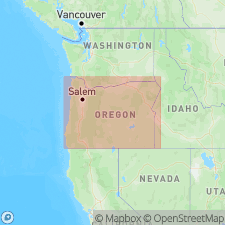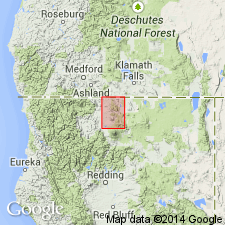
- Usage in publication:
-
- High Cascade series
- Modifications:
-
- Original reference
- Dominant lithology:
-
- Basalt
- AAPG geologic province:
-
- Western Columbia basin
Summary:
Discussion of volcanic sequence in Cascade Range in Oregon. Cascade Range south of Mount Hood divided into two parts, Western Cascades and High Cascades, on basis of pronounced unconformity in stratigraphic sequence of lavas. Rocks that form the High Cascades are characterized by large mass of gray olivine basalt, large cones composed mainly of hypersthene andesite, rhyolite and pyroclastics, and small cones, some of them quite recent, of andesite, calcic andesite, and basalt. Age is Pliocene, Pleistocene, and Recent.
Source: US geologic names lexicon (USGS Bull. 1200, p. 1756).

- Usage in publication:
-
- High Cascade series
- Modifications:
-
- Revised
- AAPG geologic province:
-
- Western Columbia basin
Summary:
Pg. 35-49. High Cascade series. Most of Macdoel quadrangle occupied by volcanic rocks. These belong to two series: first, the Western Cascade series, Eocene to Miocene and second, Cascade series of Pliocene, Pleistocene, and Recent age. Named units in area include Plutos Cave, Butte Creek, Alder Creek, Whaleback, and Copco basalts and Goosenest flows.
Source: US geologic names lexicon (USGS Bull. 1200, p. 1756).
For more information, please contact Nancy Stamm, Geologic Names Committee Secretary.
Asterisk (*) indicates published by U.S. Geological Survey authors.
"No current usage" (†) implies that a name has been abandoned or has fallen into disuse. Former usage and, if known, replacement name given in parentheses ( ).
Slash (/) indicates name conflicts with nomenclatural guidelines (CSN, 1933; ACSN, 1961, 1970; NACSN, 1983, 2005, 2021). May be explained within brackets ([ ]).

